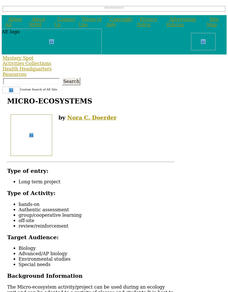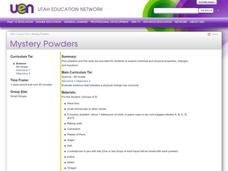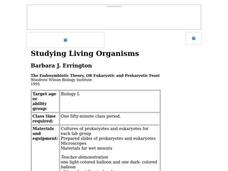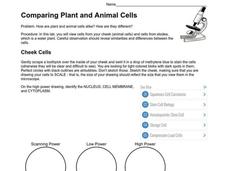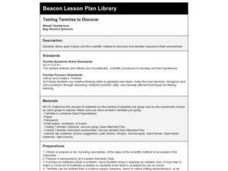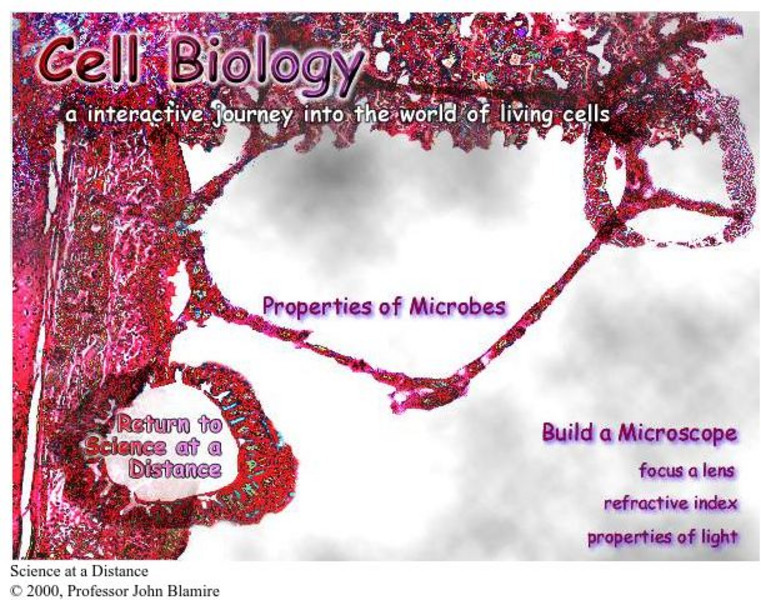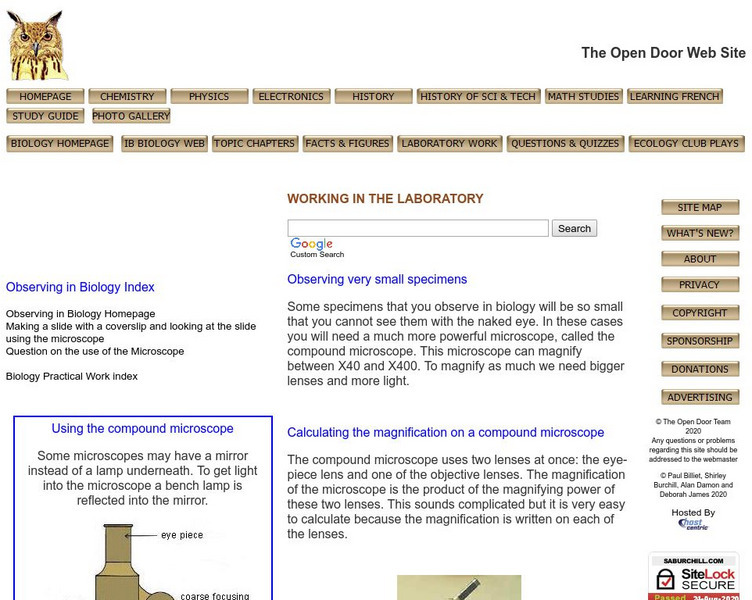Curated OER
Micro-Ecosystems
Students create a sustainable, self-contained ecosystem in a ten-gallon aquarium.
Curated OER
Mystery Powders
Fifth graders evaluate the physical properties of 5 powders. Each powder is subject to different conditions. They describe each observation as with a chemical change or a physical change.
Curated OER
The Great Archeological Dig
Students explore biology by identifying a diagram. In this cell anatomy instructional activity, students read a story about archeology and conduct a fictitious archeology dig in class in which they search for animal cells. Students...
Curated OER
The Human Cheek Cell
Young scholars list the parts of cell theory and describe and define vocabulary. In this cell lesson students complete a handout that includes sketching a cell.
Curated OER
Studying Living Organisms
Students are introduced to Hardy-Weinberg Equilibrium without recourse to algebra. After participating in this activity, students gain a feeling for the significance of the Hardy-Weinberg Equilibrium without using algebra.
Curated OER
Electric Circuits
Students explore energy by completing an electricity worksheet. In this conductors lesson, students define the energy related vocabulary terms circuit, electronics, conductor and semi-conductor before examining computer chips in class....
Curated OER
Mold
Students explore mold, the different types and the health risks that they pose. In this mycelium lesson students grow different molds and see which type of foods mold the fastest.
Curated OER
Flatworms- Observations of a Live Planarian
In this flatworm worksheet, learners observe a flatworm in a petri dish. Students describe the flatwork and measure the planarian. Learners complete the various charts about the movement and observations of the planarian.
Curated OER
Comparing Plant and Animal Cells
In this comparing plant cells and animal cells worksheet, students view cells from their cheeks and cells from elodea. A Venn diagram reveals similarities and differences between the cells.
Curated OER
Inquiry-based Investigations into Pond Water Microorganisms
Pupils become familiar with common microorganisms and experience exploring the microbial world.
Curated OER
Temperature and Brine Shrimp Eggs
Students determine the optimal temperature at which brine shrimp eggs hatch and develop. They evaluate the changes, if any, which occur in a brine shrimp culture at various temperatures.
Curated OER
DOES A FLUCTUATION IN TEMPERATURE IFFECT THE GROWTH AND SURVIVAL RATE OF AQUATIC PLANTS?
Students determine if different temperatures effect the growth and survival rates of aquatic plants and evaluate the optimal temperature for the growth of aquatic plants.
Curated OER
Quantum Mechanics and Atomic Physics
Students will discuss the de Brogile Hypothesis and state the circumstances under which the wave nature of matter is observed. They will also calculate the wavelengths of matter waves.
Curated OER
Testing Termites to Discover
Students design an experiment to discover how termites respond to their environment.
Alabama Learning Exchange
Alex: Introduction to the Light Microscope
This is a Microscope Internet Lab that can be used as a virtual lab for a whole class or as a make-up lab. The virtual microscope is a little more complicated than the microscope that is used in the labs but it will not be difficult to...
South Carolina Educational Television
Know It All: Microscope | Hobby Shop
In this activity, students use a virtual biology lab to perform investigations and learn lab procedures using compound and dissecting microscopes to look at a variety of animal and plant cells.
Other
Usda: Virtual Labs: How to Use Oil Immersion Microscope
In this science simulation, students learn how to use a microscope as they investigate bacterial contamination in a sample of yogurt.
City University of New York
Cell Biology: An Interactive Journey
This interactive website about microscopes and microbes provides students with an introduction to cellular biology.
Lawrence Berkeley National Laboratory
Berkeley Lab: The Particle Adventure: Wavelength, the Cave
This analogy story explains the manner in which the wavelength of light affects the maximum resolution of a microscope.
CK-12 Foundation
Ck 12: Biology: Laboratories
[Free Registration/Login may be required to access all resource tools.] Describes a scientific laboratory, lab equipment, and lab safety.
Open Door Team
Open Door Web Site: Biology: Calculating Magnification on a Compound Microscope
Learn how to calculate the total magnification of a microscope on this concise site. Links to making a slide, questions on the use of the microscope, and other related microscope topics are included on this site.
Department of Defense
Do Dea: Biology: Unit 3: Cell Structure
In this third unit of a Biology course, students learn about cells and cell structure. They compare prokaryotic and eukaryotic cells and learn about the specialized structures in a cell and what their functions are. They will also learn...
Curated OER
Ntnu Virtual Physics Lab: Thin Lens Combination
A Java applet which allows the user to emulate a refracting telescope and a light microscope. This is a great site to get information on the subject and better understand it through diagrams and charts.
Curated OER
Ntnu Virtual Physics Lab: Thin Lens Combination
A Java applet which allows the user to emulate a refracting telescope and a light microscope. This is a great site to get information on the subject and better understand it through diagrams and charts.


